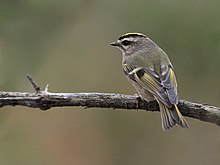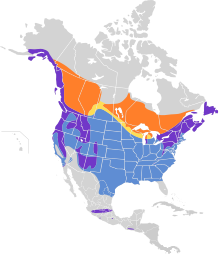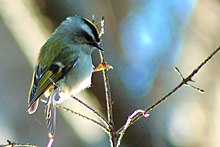339:
243:
82:
295:
38:
203:
57:
407:
in two other regards: the white supercilium stops short of the rear of the crown, whereas on the other two species the supercilium extends farther back, and the wingbars are wide, and white (or slightly lemon-tinged) compared with narrow dingy whitish (or lemon- or olive-washed) wingbars of the other
253:
Adults are olive-gray on the upperparts with white underparts, with thin bills and short tails. They have white wing bars, a black stripe through the eyes and a yellow crown surrounded by black. The adult male has an orange patch in the middle of the yellow crown. The juvenile is similar to the
262:. Its length, at 8 to 11 cm (3.1 to 4.3 in), is probably the shortest of any American passerine. Its weight, averaging 6.1 g (0.22 oz) for females and 6.3 g (0.22 oz) for males and ranging from 4.5 to 7.8 g (0.16 to 0.28 oz), is similar to the
892:
358:, but frequently given family status, especially as recent research showed that, despite superficial similarities, the crests are taxonomically remote from the warblers. The names of the family, Regulidae, and its only genus,
387:, breeding and wintering from southern Alaska and the southern Yukon to southwestern California and southern New Mexico. This subspecies is medium-small, has a long bill, and has the back and rump bright yellowish-olive.
326:. It migrates to the United States in the non-breeding season. Some birds are permanent residents in coastal regions and in the southern parts of their range. Northern birds remain further north in winter than the
393:, breeding from coastal southeastern Alaska to southwestern Oregon, wintering to Idaho and southwestern California. This subspecies is small, with a medium-long bill, and has the back and rump dark greenish-olive.
802:
430:
in south-central Mexico, in the mountains from
Michoacán south to Oaxaca. This subspecies is dark greenish above, has poorly developed wing markings, and its underparts are washed greyish-brown.
399:, breeding from northern Alberta to Newfoundland and North Carolina. This subspecies is large, with a short bill, has the back and rump olive with a greyish wash. It further differs from
210:
Range map of the golden-crowned kinglet. The breeding range is highlighted in orange, the migration range in yellow, the non-breeding range in blue, and the year-round range in purple.
286:. It produces a series of high-pitched calls on a single note, and tends not to fear human approach. Its nest is a well-concealed hanging cup suspended from a conifer branch.
423:
Two other (non-migratory) subspecies occur south of the bird's core range, although these are weakly differentiated from each other and so are perhaps best synonymised:
1301:
380:
in the United States and Canada, differing in size, bill length, back and rump colours, wing bar width and colour, and length of supercilium:
1353:
1433:
1458:
649:
Harrison, H. H. (1975). A field guide to birds’ nests found east of the
Mississippi River. Houghton Mifflin Co., Boston, Massachusetts.
680:"A phylogenetic hypothesis for passerine birds: taxonomic and biogeographic implications of an analysis of nuclear DNA sequence data"
1252:
1314:
1379:
844:
812:
553:
528:
1319:
1275:
932:
830:
1448:
780:
1453:
863:
1358:
1443:
1280:
1239:
729:"Molecular phylogeny of songbirds (Passerifor-mes) inferred from mitochondrial 16S ribosomal RNA gene sequences"
1127:
1371:
1177:
879:
728:
1182:
489:
1156:
1118:
81:
1366:
884:
267:
1345:
1267:
1438:
595:
520:
513:
282:, foraging in trees or shrubs, where it eats insects (especially caterpillars), insect eggs and
1306:
1164:
1080:
925:
827:
Martens, Jochen; Päckert, Martin "Family
Regulidae (Kinglets & Firecrests)" pp. 330–349 in
659:
Monroe, Burt L. (February 1992). "The new DNA-DNA avian classification: What's it all about?".
1332:
1397:
176:
1169:
1138:
1063:
445:
327:
247:
8:
770:
466:
338:
254:
adult, but with a browner back and without the yellow crown. This is one of the smallest
192:
46:
1143:
869:
704:
679:
632:
436:
in the mountains of
Chiapas, southern Mexico, and Guatemala. This subspecies resembles
373:, "a king", and refer to the characteristic orange or yellow crests of adult kinglets.
76:
747:
420:, as the distinctions between these populations are obscured by individual variation.
1392:
1200:
1035:
918:
840:
832:
Handbook of the Birds of the World: Old World
Flycatchers to Old World Warblers v. 11
808:
776:
751:
709:
549:
524:
355:
298:
The golden-crowned kinglet is a non-breeding resident in the winter in North
Carolina
596:"Golden-crowned Kinglet Identification, All About Birds, Cornell Lab of Ornithology"
1205:
1030:
974:
898:
743:
699:
691:
484:
263:
1244:
1410:
1192:
952:
570:
Ecological complementarity of three sympatric parids in a
California oak woodland
343:
323:
1103:
1016:
303:
153:
242:
1427:
1327:
959:
836:
475:
315:
294:
259:
66:
61:
37:
755:
713:
695:
270:. The golden-crowned kinglet has a wingspan of 5.5-7.1 in (14-18 cm).
1340:
1288:
1112:
905:
677:
279:
1405:
1257:
1040:
636:
621:"Winter Food of a Small Insectivorous Bird, the Golden-Crowned Kinglet"
620:
377:
1293:
202:
1226:
1025:
255:
231:
133:
93:
20:
1074:
1231:
1218:
1097:
969:
829:
del Hoyo, Josep; Elliott, Andrew; Christie, David A., eds. (2006).
227:
113:
354:
The kinglets are a small group of birds sometimes included in the
1384:
1151:
1002:
941:
307:
143:
583:
Speciation and geographic variation in Black-tailed
Gnatcatchers
775:(10th ed.). Edinburgh: Chambers. pp. 223, 735, 1277.
678:
Barker, F Keith; Barrowclough, George F; Groth, Jeff G (2002).
319:
311:
283:
246:
The golden-crowned kinglet is generally similar to the related
103:
1213:
990:
363:
807:. Bolinas, California: Slate Creek Press. pp. 374–375.
910:
458:
123:
568:
Hertz, P. E., J. V. Remsen, Jr., and S. I. Jones. 1976.
828:
306:
bird throughout North
America. Its breeding habitat is
726:
464:
804:
Identification Guide to North
American Birds Part 1
512:
490:10.2305/IUCN.UK.2018-2.RLTS.T22712594A132100712.en
1425:
875:– USGS Patuxent Bird Identification InfoCenter
926:
448:has been reported to have possibly occurred.
440:but is paler and duller, with a shorter tail.
234:that lives throughout much of North America.
684:Proceedings of the Royal Society of London B
618:
543:
302:The golden-crowned kinglet is a widespread
933:
919:
201:
55:
36:
727:Spicer, Greg S; Dunipace, Leslie (2004).
703:
488:
762:
548:(2nd ed.). CRC Press. p. 344.
337:
293:
241:
796:
794:
792:
768:
342:Golden-crowned kinglet hanging from an
1426:
1281:golden-crowned-kinglet-regulus-satrapa
864:Golden-crowned Kinglet Species Account
720:
671:
658:
510:
1079:
1078:
914:
736:Molecular Phylogenetics and Evolution
519:. New York: Alfred A. Knopf. p.
504:
893:Golden-crowned Kinglet photo gallery
800:
789:
652:
619:Heinrich, Bernd; Bell, Ross (1995).
1434:IUCN Red List least concern species
821:
476:IUCN Red List of Threatened Species
13:
1459:Taxa named by Hinrich Lichtenstein
14:
1470:
857:
546:CRC Handbook of Avian Body Masses
80:
465:BirdLife International (2018).
314:, the northeastern and western
289:
880:"Golden-crowned Kinglet media"
643:
612:
588:
575:
562:
544:Dunning, Jr., John B. (2008).
537:
278:The golden-crowned kinglet is
237:
1:
748:10.1016/S1055-7903(03)00193-3
451:
940:
895:at VIREO (Drexel University)
866:– Cornell Lab of Ornithology
511:Sibley, David Allen (2000).
416:" has been synonymised with
19:Not to be confused with the
7:
1000:
333:
10:
1475:
769:Brookes, Ian, ed. (2006).
376:There are three migratory
273:
18:
1087:
1054:
1014:
999:
988:
948:
899:Interactive range map of
870:Golden-crowned Kinglet –
515:The Sibley Guide to Birds
483:: e.T22712594A132100712.
209:
200:
182:
175:
77:Scientific classification
75:
53:
44:
35:
30:
1449:Birds of Central America
885:Internet Bird Collection
268:black-tailed gnatcatcher
1454:Birds described in 1823
772:The Chambers Dictionary
362:, are derived from the
31:Golden-crowned kinglet
1444:Birds of North America
1268:golden-crowned-kinglet
1046:Golden-crowned kinglet
696:10.1098/rspb.2001.1883
585:. Ornithol. Monogr. 42
351:
299:
250:
218:golden-crowned kinglet
600:www.allaboutbirds.org
446:ruby-crowned kinglets
341:
297:
245:
1064:Ruby-crowned kinglet
801:Pyle, Peter (1997).
581:Atwood, J. L. 1988.
572:. Condor 78:307–316.
348:Juniperus virginiana
328:ruby-crowned kinglet
248:ruby-crowned kinglet
625:The Wilson Bulletin
444:Hybridization with
47:Conservation status
906:IUCN Red List maps
639:– via JSTOR.
369:, a diminutive of
356:Old World warblers
352:
300:
251:
226:) is a very small
1421:
1420:
1393:Open Tree of Life
1081:Taxon identifiers
1072:
1071:
1036:Madeira firecrest
1010:
1009:
846:978-84-96553-06-4
814:978-0-9618940-2-3
690:(1488): 295–308.
555:978-1-4200-6444-5
530:978-0-679-45122-8
214:
213:
193:Lichtenstein, MHC
70:
1466:
1414:
1413:
1401:
1400:
1388:
1387:
1375:
1374:
1362:
1361:
1349:
1348:
1336:
1335:
1323:
1322:
1310:
1309:
1297:
1296:
1284:
1283:
1271:
1270:
1261:
1260:
1248:
1247:
1235:
1234:
1222:
1221:
1209:
1208:
1196:
1195:
1186:
1185:
1173:
1172:
1160:
1159:
1157:154BCCAE37AE70E9
1147:
1146:
1134:
1133:
1123:
1122:
1121:
1108:
1107:
1106:
1076:
1075:
1031:Common firecrest
997:
996:
935:
928:
921:
912:
911:
889:
851:
850:
825:
819:
818:
798:
787:
786:
766:
760:
759:
733:
724:
718:
717:
707:
675:
669:
668:
656:
650:
647:
641:
640:
616:
610:
609:
607:
606:
592:
586:
579:
573:
566:
560:
559:
541:
535:
534:
518:
508:
502:
501:
499:
497:
492:
462:
412:The subspecies "
264:American bushtit
205:
188:
85:
84:
64:
59:
58:
40:
28:
27:
1474:
1473:
1469:
1468:
1467:
1465:
1464:
1463:
1424:
1423:
1422:
1417:
1411:Regulus-satrapa
1409:
1404:
1396:
1391:
1383:
1378:
1370:
1365:
1357:
1352:
1344:
1339:
1331:
1326:
1318:
1313:
1305:
1300:
1292:
1287:
1279:
1274:
1266:
1264:
1256:
1251:
1243:
1238:
1230:
1225:
1217:
1212:
1204:
1199:
1191:
1189:
1181:
1176:
1168:
1163:
1155:
1150:
1144:Regulus_satrapa
1142:
1137:
1131:
1126:
1119:Regulus satrapa
1117:
1116:
1111:
1102:
1101:
1096:
1089:Regulus satrapa
1083:
1073:
1068:
1050:
1006:
984:
944:
939:
901:Regulus satrapa
878:
872:Regulus satrapa
860:
855:
854:
847:
826:
822:
815:
799:
790:
783:
767:
763:
731:
725:
721:
676:
672:
657:
653:
648:
644:
617:
613:
604:
602:
594:
593:
589:
580:
576:
567:
563:
556:
542:
538:
531:
509:
505:
495:
493:
469:Regulus satrapa
463:
459:
454:
408:two subspecies.
391:R. s. olivaceus
344:Eastern juniper
336:
324:Central America
310:forests across
292:
276:
240:
223:Regulus satrapa
196:
190:
186:Regulus satrapa
184:
171:
168:R. satrapa
79:
71:
60:
56:
49:
24:
17:
16:Species of bird
12:
11:
5:
1472:
1462:
1461:
1456:
1451:
1446:
1441:
1439:Regulus (bird)
1436:
1419:
1418:
1416:
1415:
1402:
1389:
1376:
1363:
1350:
1337:
1324:
1311:
1298:
1285:
1272:
1262:
1249:
1236:
1223:
1210:
1197:
1187:
1174:
1161:
1148:
1135:
1124:
1109:
1093:
1091:
1085:
1084:
1070:
1069:
1067:
1066:
1060:
1058:
1052:
1051:
1049:
1048:
1043:
1038:
1033:
1028:
1022:
1020:
1012:
1011:
1008:
1007:
994:
986:
985:
983:
982:
979:
977:
972:
967:
965:
962:
957:
955:
949:
946:
945:
938:
937:
930:
923:
915:
909:
908:
896:
890:
876:
867:
859:
858:External links
856:
853:
852:
845:
820:
813:
788:
781:
761:
742:(2): 325–335.
719:
670:
651:
642:
631:(3): 558–561.
611:
587:
574:
561:
554:
536:
529:
503:
456:
455:
453:
450:
442:
441:
431:
410:
409:
394:
388:
335:
332:
291:
288:
275:
272:
239:
236:
230:in the family
212:
211:
207:
206:
198:
197:
191:
180:
179:
173:
172:
165:
163:
159:
158:
151:
147:
146:
141:
137:
136:
131:
127:
126:
121:
117:
116:
111:
107:
106:
101:
97:
96:
91:
87:
86:
73:
72:
54:
51:
50:
45:
42:
41:
33:
32:
15:
9:
6:
4:
3:
2:
1471:
1460:
1457:
1455:
1452:
1450:
1447:
1445:
1442:
1440:
1437:
1435:
1432:
1431:
1429:
1412:
1407:
1403:
1399:
1394:
1390:
1386:
1381:
1377:
1373:
1368:
1364:
1360:
1355:
1351:
1347:
1342:
1338:
1334:
1329:
1325:
1321:
1316:
1312:
1308:
1303:
1299:
1295:
1290:
1286:
1282:
1277:
1273:
1269:
1263:
1259:
1254:
1250:
1246:
1241:
1237:
1233:
1228:
1224:
1220:
1215:
1211:
1207:
1202:
1198:
1194:
1188:
1184:
1179:
1175:
1171:
1166:
1162:
1158:
1153:
1149:
1145:
1140:
1136:
1129:
1125:
1120:
1114:
1110:
1105:
1099:
1095:
1094:
1092:
1090:
1086:
1082:
1077:
1065:
1062:
1061:
1059:
1057:
1053:
1047:
1044:
1042:
1039:
1037:
1034:
1032:
1029:
1027:
1024:
1023:
1021:
1019:
1018:
1013:
1005:
1004:
998:
995:
993:
992:
987:
980:
978:
976:
973:
971:
968:
966:
963:
961:
960:Passeriformes
958:
956:
954:
951:
950:
947:
943:
936:
931:
929:
924:
922:
917:
916:
913:
907:
903:
902:
897:
894:
891:
887:
886:
881:
877:
874:
873:
868:
865:
862:
861:
848:
842:
838:
837:Lynx Edicions
835:. Barcelona:
834:
833:
824:
816:
810:
806:
805:
797:
795:
793:
784:
782:9780550101853
778:
774:
773:
765:
757:
753:
749:
745:
741:
737:
730:
723:
715:
711:
706:
701:
697:
693:
689:
685:
681:
674:
666:
662:
661:British Birds
655:
646:
638:
634:
630:
626:
622:
615:
601:
597:
591:
584:
578:
571:
565:
557:
551:
547:
540:
532:
526:
522:
517:
516:
507:
491:
486:
482:
478:
477:
472:
470:
461:
457:
449:
447:
439:
435:
432:
429:
428:R. s. aztecus
426:
425:
424:
421:
419:
415:
406:
402:
398:
397:R. s. satrapa
395:
392:
389:
386:
383:
382:
381:
379:
374:
372:
368:
365:
361:
357:
349:
345:
340:
331:
329:
325:
321:
317:
316:United States
313:
309:
305:
296:
287:
285:
281:
280:insectivorous
271:
269:
265:
261:
260:North America
257:
249:
244:
235:
233:
229:
225:
224:
219:
208:
204:
199:
194:
189:
187:
181:
178:
177:Binomial name
174:
170:
169:
164:
161:
160:
157:
156:
152:
149:
148:
145:
142:
139:
138:
135:
134:Passeriformes
132:
129:
128:
125:
122:
119:
118:
115:
112:
109:
108:
105:
102:
99:
98:
95:
92:
89:
88:
83:
78:
74:
68:
63:
62:Least Concern
52:
48:
43:
39:
34:
29:
26:
22:
1088:
1055:
1045:
1015:
1001:
989:
900:
883:
871:
831:
823:
803:
771:
764:
739:
735:
722:
687:
683:
673:
664:
660:
654:
645:
628:
624:
614:
603:. Retrieved
599:
590:
582:
577:
569:
564:
545:
539:
514:
506:
494:. Retrieved
480:
474:
468:
460:
443:
437:
434:R. s. clarus
433:
427:
422:
417:
413:
411:
404:
400:
396:
390:
385:R. s. apache
384:
375:
370:
366:
359:
353:
347:
301:
290:Distribution
277:
252:
222:
221:
217:
215:
185:
183:
167:
166:
154:
25:
1367:Neotropical
1341:NatureServe
1289:iNaturalist
1113:Wikispecies
667:(2): 53–61.
496:11 November
238:Description
1428:Categories
1406:Xeno-canto
1041:Flamecrest
605:2020-09-29
452:References
378:subspecies
308:coniferous
256:passerines
1056:Corthylio
1026:Goldcrest
981:Regulidae
405:olivaceus
304:migratory
232:Regulidae
162:Species:
144:Regulidae
100:Kingdom:
94:Eukaryota
21:Goldcrest
1346:2.100997
1333:22712594
1307:11269850
1170:22712594
1165:BirdLife
1104:Q1063246
1098:Wikidata
964:Suborder
942:Kinglets
756:14715224
714:11839199
334:Taxonomy
228:songbird
140:Family:
114:Chordata
110:Phylum:
104:Animalia
90:Domain:
67:IUCN 3.1
1398:3599325
1385:1484561
1258:2484591
1152:Avibase
1017:Regulus
1003:Species
970:Passeri
705:1690884
637:4163582
438:aztecus
414:amoenus
367:regulus
360:Regulus
284:spiders
274:Ecology
155:Regulus
150:Genus:
130:Order:
120:Class:
65: (
1372:gockin
1320:179865
1294:117100
1265:GNAB:
1240:EURING
1232:REGUSA
1219:gockin
1193:gockin
1132:gocrki
975:Family
843:
811:
779:
754:
712:
702:
635:
552:
527:
418:apache
401:apache
320:Mexico
312:Canada
195:, 1823
1359:13245
1302:IRMNG
1245:13160
1214:eBird
1206:4RPWB
1190:BOW:
991:Genus
953:Order
732:(PDF)
633:JSTOR
364:Latin
1380:OBIS
1354:NCBI
1328:IUCN
1315:ITIS
1253:GBIF
1227:EPPO
1183:9656
1178:BOLD
841:ISBN
809:ISBN
777:ISBN
752:PMID
710:PMID
550:ISBN
525:ISBN
498:2021
481:2018
403:and
322:and
266:and
216:The
124:Aves
1276:IBC
1201:CoL
1139:ADW
1128:ABA
904:at
744:doi
700:PMC
692:doi
688:269
629:107
521:394
485:doi
371:rex
258:in
1430::
1408::
1395::
1382::
1369::
1356::
1343::
1330::
1317::
1304::
1291::
1278::
1255::
1242::
1229::
1216::
1203::
1180::
1167::
1154::
1141::
1130::
1115::
1100::
882:.
839:.
791:^
750:.
740:30
738:.
734:.
708:.
698:.
686:.
682:.
665:85
663:.
627:.
623:.
598:.
523:.
479:.
473:.
330:.
318:,
934:e
927:t
920:v
888:.
849:.
817:.
785:.
758:.
746::
716:.
694::
608:.
558:.
533:.
500:.
487::
471:"
467:"
350:)
346:(
220:(
69:)
23:.
Text is available under the Creative Commons Attribution-ShareAlike License. Additional terms may apply.



